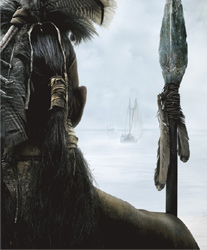|
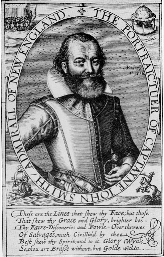 The story of Virginia Beach has so many fascinating chapters that we can barely do it justice here. To learn more about the events that have shaped our town, there are several books you can look for. One book that helped immensely in the creation of this site was: "Virginia Beach, A Pictorial History" by James M. Jordan and Frederick S. Jordan, 1973 Hale Publishing Co. Another book of immense value is " The Beach " compiled and revised by the Virginia Beach Public Library, which is currently in print and available. It offers a very complete history and lots of little known facts about our town. The story of Virginia Beach has so many fascinating chapters that we can barely do it justice here. To learn more about the events that have shaped our town, there are several books you can look for. One book that helped immensely in the creation of this site was: "Virginia Beach, A Pictorial History" by James M. Jordan and Frederick S. Jordan, 1973 Hale Publishing Co. Another book of immense value is " The Beach " compiled and revised by the Virginia Beach Public Library, which is currently in print and available. It offers a very complete history and lots of little known facts about our town.
Contrary to popular belief, John Smith was not among the first landing party in the new world. When Admiral Christopher Newport organized the 30 or so men who were to go ashore, Smith was under arrest and in chains for taking part in mutinous disturbances en route to the new world.
Nevertheless, the landing party came ashore in the present city of Virginia Beach on the morning of April 26th, 1607. It was springtime and as the adventurers climbed the huge sand dunes their view of the dogwood trees in full bloom, and the climbing yellow jasmines intermingled with the deep green recesses on the woodland moved 26 year old Master George Percy to write that, "Heaven and Earth never agreed better to frame a place for man's habitations than Virginia."
On April 29th, the voyagers returned to the entrance of the great body of water they officially named The Chesapeake Bay, using the same name the Indians used. There they erected a cross and named the spot Cape Henry, after the popular Prince of Wales, who was only 13 at the time. They claimed all the land in the name of God and England and on the sand of Virginia Beach conducted the first religious ceremony of the Church of England in America.
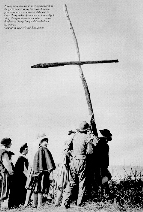 The First Landing The First Landing
Captain Newport, fearing the landing site too vulnerable to Spanish and Indian attack, moved his colonists farther inland to establish the Capital City. On May 13, 1607, he chose a small island on the James River to establish the first permanent English Colony in the new world. King James had ordered that the capital city be named in his honor, hence Jamestown was born.
The Virginia Colony was settled in a haphazard fashion. It was not until 14 years after the first landing at Cape Henry that colonists settled in the area that is now Virginia Beach.
The slow early growth of Virginia Beach is somewhat puzzling due to the known abundance of natural resources available then. Besides being relatively free of Indians and the supposed threat they posed, there was an unlimited supply of wildlife, the most fertile soil in the entire colony, numerous deep rivers ideal for transportation and excellent accessibility to the resources of the sea.
One of the earliest residents of Virginia Beach was Adam Thoroughgood, who at age 18, had left the home of his prominent family at Kings Lynn, Norfolkshire, England, to seek adventure and fortune in the colony of Virginia. The topography reminded young Thoroughgood so much of his homeland that he gave the river and her shores the name Lynnhaven. Thoroughgood soon became the leading citizen in Lynnhaven Parish, and was an elected member of the House of Burgess, the Governors Council, and a Justice of the Court.
In 1635 Captain Thoroughgood (he held a commission in the county militia) earned a land grant of 5,350 acres in colonial Virginia Beach for having persuaded 105 people to settle in Virginia. Interestingly, included in these 105 immigrants was Augustine Warner, progenitor of George Washington, and generations later Robert E. Lee. During the following year, 1636, Thouroughgood built a modest but substantial brick home for his family on the western branch of the Lynnhaven River. This house, still standing and fully restored, is believed to be the oldest surviving brick home in America.
Thoroughgood died suddenly at the age of 36, but his character and ideals had been embedded in the land and people of Lynnhaven. During the ensuing years the Lynnhaven area began to flourish under the leadership of prominent families such as the Keeling, Cornicks, Woodhouses and Strattons.
Because of the abundance of fish in the Chesapeake Bay area, seine hauling was one of the early profitable vocations taken up by the residents along the shores of the lynnhaven. At this stage in history the only entrance into the Lynnhaven River from the Chesapeake Bay was by way of Little Creek and was reported to be a tedious journey of three miles. It did not take the fishermen long to realize that a shorter, faster route to the bay would greatly enhance the profits of those associated with the fishing industry. Adam Keeling, whose plantation, "Ye Dudlies," was situated right at the mouth of the Lynnhaven River, organized a group of people to work out a solution for this situation.
At the mouth of the Lynnhaven there was a huge sandbar about a half-mile wide, separating the River and Bay. Keeling's group dug a trench across the sandbar wide enough to permit the passage of a canoe. Almost immediately after this feat was accomplished, a severe storm out of the northeast caused unusually high tides in the Chesapeake to rush through the ditch into the Lynnhaven River. The force of the tides enlarged the ditch to the size of an inlet, and today this inlet is known as the famous Lynnhaven Inlet.
The Wreck of the Benjamin F. Poole 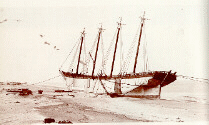 The Benjamin F. Poole The Benjamin F. Poole
During a violent spring storm that hit Virginia Beach on April 7, 1889, more than forty ships were wrecked between Cape Henry and Cape Hatteras. One of the ships that survived the storm was the "Benjamin F. Poole" of Providence, Rhode Island. Where the wreck of the "Dictator" was the most tragic in Virginia Beach's history, the wreck of the "Benjamin F. Poole" was the most amusing. The four-masted schooner was bound for Baltimore to pick up a cargo of coal when it was caught in the storm. The ship's captain, Hjalmar Charlton, tried in vain to steer his vessel to the confines of the Chesapeake Bay, and finally was forced to beach his ship, else it be broken up by the force of the storm. The ship came ashore between 16th & 17th Streets, and the entire crew was rescued in a breeches buoy by the crew of the Seatack Lifesaving Station. The ship was left so high and dry after the storm had passed that one was able to walk completely around the ship at low tide in dry sand. The Merit Wrecking Company was hired to attempt to float the ship, but all attempts failed. Realizing that an unusually high tide would be the only way to float the ship, the wrecking crew built a coffer dam around the ship forming a dry dock of sorts. Additionally, a heavy rope was extended out into the ocean, attached to the ships anchor and marked by a buoy.
The ship had been on the beach for some fifteen months when Captain Charlton got married in July of 1890, and he and his new bride spent their honeymoon aboard the stranded ship. The accommodations for the honeymooners were quite luxurious, for the Captain's quarters were handsomely paneled and decorated. All of their meals were served by the ship's steward. The couple literally had the beach and ocean right at their doorstep. Captain and Mrs. Charlton decided to set up housekeeping on the ship, and spent an enjoyable summer meeting the curious folks who came to see their stranded ship.
Finally on September 28, 1890, after seventeen months, a three-day northeaster hit Virginia Beach and brought on the necessary tides to get the ship afloat. After being overhauled, the ship sailed the seas for many years. Thus ended the most unusual honeymoon in the history of Virginia Beach.
Grace Sherwood: The Witch of Virginia Beach 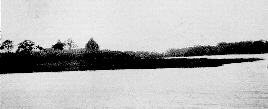 The site where The site where
Grace Sherwood
was "Ducked"
Early court records tell the tale of Grace Sherwood, who was tried in 1706 as Virginia Beach's first witch. Alas, there are no existing images of Grace, (hence this non-descript photo).
Her story is perhaps the most fascinating folklore in the history of Tidewater. Witchcraft was a very serious and real thing to the colonists. The cult was believed to be a threat to the Christian Church, and everyone during the early 1700's was on the lookout for witches, who could be recognized by so-called unusual or mysterious behaviors.
Grace lived her entire life in the Pungo area of Virginia Beach (named for Indian chief Machiopungo), and married James Sherwood with whom she had three sons. She was said to be strikingly attractive, strong-willed, and a non-conformist by nature. These traits were resented by her neighbors, who began spreading rumors about her witch-like behavior. She was accused of blighting gardens, causing livestock to die, and influencing the weather.
After eight years of constant slander and bickering by her neighbors, Grace was formally charged with suspicions of witchcraft. A jury of women was ordered to search her body for suspicious or unusual markings, thought to be brands of the devil himself, and naturally the jury found, "marks not like theirs or like those of any other woman." However, neither the local court nor the Attorney General in Williamsburg, would pass judgment declaring her a witch. It was finally decided that Grace, "by her own consent, be tried in the water by Ducking, (dunking)." Water was considered to be the purest element and the theory was that it would reject anything of an evil nature. Based on this theory, the accused was tied up and thrown into the water. If the person drowned, he was declared innocent of witchcraft; if he could stay afloat until he could free himself, he or she was declared a witch.
On July 10, 1706, Grace was marched from the jail (which located near the present day site of Old Donation Church) down the dirt road (now Witch Duck Road) to the Lynnhaven River. This portion of the river has since been named Witch Duck Bay in memory of the occasion. This being a big event, hoards of people from all over the colony flocked to the scene as news of the Ducking had spread throughout the Commonwealth.
Grace Sherwood was tied crossbound with the thumb of her right hand to the big toe of her left foot, and the thumb of her left hand to the big toe of her right foot, and thrown into the water. As predicted by her accusers, Grace managed to stay afloat until she could free herself and swim to shore. She was jailed and awaiting trial for witchcraft for nearly eight years, when the charges against her were dropped due to the softening of her accusers hearts, and she was set free. She moved back to her Pungo home and lived there until her death at the age of 80.
Many stories have been told and retold over the years about this most remarkable woman. One of the many tall tales that have been handed down from generation to generation has to do with the day of her ducking. When they led Grace Sherwood through the crowd that had turned out to see her put into the water she told them, "All right, all of you po' white trash, you've worn out your shoes traipsin' here to see me ducked, but before you'll get back home again you are goin' to get the duckin' of your lives." When they put Grace into the water the sky was as bright blue as a bird's wing, but immediately afterward it grew pitch black, the thunder rolled and the lightning flashed all across the heavens. The terrified people started for home, only to be washed off the roads and into the ditches by a powerful cloudburst.
The Revolutionary War in Virginia Beach 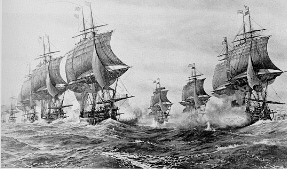 Revolutionary War Naval Battle Revolutionary War Naval Battle
The Revolutionary War was a most difficult time for the people of Virginia Beach, as they were torn between their love of the mother country, and their desire for a new democracy. Fortunately there was very little fighting in Virginia Beach during the Revolution. However, there was a small skirmish on November 6th, 1775, at kempsville in which one colonist was killed. This was reportedly the first battle of the Revolutionary War in the Virginia Colony.
Even though no major land battles took place on the soil of Virginia Beach, many historians feel that Washington's victory over Cornwallis at Yorktown was strategically won in a sea battle off Cape Henry. From the beginning of the war and up to August 1781, the British controlled the waterways of Virginia. However, the French fleet under Admiral De Grasse defeated the British fleet in a bloody two-day sea battle off the coast of Cape Henry. The mouth of the Chesapeake was no longer controlled by the British, and Cornwallis was cut off from needed supplies and reinforcements from England. The British Army was therefore left helpless in a hostile land and was forced to surrender on October 19, 1781.
Cape Henry Lighthouse 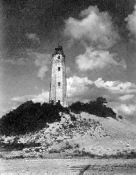 The Old Cape Henry Light House The Old Cape Henry Light House
As early as 1627, the General Assembly recommended that a signal on Cape Henry be erected to mark the entrance into Chesapeake Bay. The idea only proved to be a dream, as the early colonists were forced to devote their efforts towards survival, rather than the building of a signal station at Cape Henry. The suggestion wasn't brought up again for 100 years. In 1727, the Virginia House of Burgesses passed a resolution that it was absolutely necessary to establish a light at cape Henry. Commerce had become a great industry in the Virginia Colony by this time and the importance of a permanent lighthouse to be a guide for ships at night was even more evident.
Until the lighthouse was completed, the colonists planned to use a bonfire system, which would be fed by volunteers with pine knots throughout the night. Unfortunately, piracy grew in the colony just as fast as commerce did, and the pirates were able to take advantage of this bonfire system. They would kill the fire-keepers, extinguish the bonfire, and build another fire farther down the beach. |
